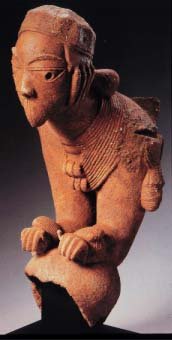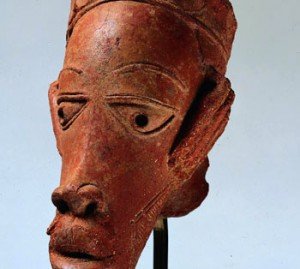Nok culture and art
NOK culture is a culture which provides evidence of the earliest ancient civilization of Nigeria. Nok culture is named after the city, Nok in the present Kaduna State where the first finds or objects or cultural artifacts were excavated by archaeologists in 1929.
Lt Colonel John Dent – Young, an Englishman was leading some mining operations in the North -South village of Nok, during which, one of the miners found a small terra – cotta of monkey head. Other finds or objects included terracottas of human head and a foot.
Among the oldest works of art ever known in Nigeria are the Nok terra-wita heads, and terra- cotta figures. Terra-cotta is a technical work, meaning baked clay’. By 1977, about 153 Nok terra -cotta pieces had been found during mining operations accidentally.
The three main sites of excavation of Nok objects include Nok, Taruga and Katsina – Ala. A lot of materials have been discovered later by some archaeologists.
Notable among them is Bernard Fagg, a British national, who happened to
be a Research Professor of Archaeology at University of Ibadan, and one time Director of Federal Department of Antiquities (now National Commission for Museums and Monuments) who excavated some Nok sites in 1944.
He discovered a fine terra – wita head at Jemaa site which had striking stylistic resemblance to monkey’s head. Later sites of excavation include Wamba, Ankiring and Kagara etc.
Nok culture is said to have belonged to a homogenous group of people who had a well ordered economy and a good system of government. Bernard Fagg also suggested that Nok people were ancestors of the present population of Ham people because of the similarity of economy.
For example, the Ham people wear lip plug as well as ear plug, similar to those of the Nok people. Nok people knew iron-working besides making of terra-cotta objects and domestic pottery.
The men of Nok culture engaged in both iron smelting and making of terra-cotta sculptures of great power and originally by 15thCentury B.C. Infact, men of Taruga were noted for iron smelting. The remains of the oldest smelting furnaces in Nigeria and the whole of West Africa were discovered in Niger State. Nok culture flourished at the metal age.
Evidence of iron making among Nok people
There is an evidence of iron-working as well as ground stone tools. The Nok culture people made use of iron tools which enabled their culture flourish.
The iron implements of Nok culture people enhanced their farming method and they cultivated such crops like millets and other grains for their food on the open grassy land, dotted with shrubs and trees here and there. They were the first iron workers known in Sub-Saharan Africa.
They also practiced hunting besides farming. Such instruments and objects of Nok culture people include terra-cotta monkeys, terra-cotta bowls, bronze bracelets, stone bracelets, grinding stones, stone axes, stone and tin lips, quartz-stone beads, and nose plugs, iron tools and carved wooden figures etc.
The Bible gives us more clue about Ham people. The descendants of Nok people. The children of Ham were said to be rulers of the earth and founders of ancient civilizations. The sons of Ham were Cush (father of Nimrod), Canaan, Mizraim (Egypt), and Put. Nimrod was the first and last to build the city of Shinar, where God confused the language of men and scattered them. Nimrod, the grandson of Ham was a great and famous builder of cities and mighty ruler.
He had an extensively large and fortified kingdom which included Babylon, Erech and city of Accad in Mesopotamia. Besides this, he was said to be the founder of the city of Nineveh in Assyria which Prophet Jonah was assigned by God to deliver His message of Salvation to them.
Nok sculpture represents human beings, animals and plants etc. The Nok terra-cotta figures are presented in various positions. The positions include: standing; kneeling/genuflecting; sitting.
There are forms of Nok terra-cotta figures among them are;
(i) Nok kneeling figure with one arm raised to suggest a form of greeting or of aggression.
(ii)Nok seated figure in which the figure sits with its right leg bent up and left leg bent and tucked behind the foot. The head is elongated and cylindrical.
(iii) Nok kneeling figure with both arms bent, and carrying objects in both hands. It has an animal skin tied around its waist.
(iv) Nok seated figure with its beard resting on the knee.
(v) Nok kneeling figure with lost raised arm, and its left hand holds the end of an implement which hooks over its shoulder.
(vi) Some with their chins resting on their knees; an arm, lifted to the head, or both arms crossed in their laps.
It is said that about 60% of Nok terra-cotta figures are males, which are identified by their attire, body decorations, hairdos, smell, beards, and moustache. The Nok terra-cotta objects are used for rituals and as commemorative sculptures of local chiefs, or dignitaries, kings, queens and priests.

Source
Plagiarism is the copying & pasting of others work without giving credit to the original author or artist. Plagiarized posts are considered spam.
Spam is discouraged by the community, and may result in action from the cheetah bot.
More information and tips on sharing content.
If you believe this comment is in error, please contact us in #disputes on Discord
Hi! I am a robot. I just upvoted you! I found similar content that readers might be interested in:
https://www.vanguardngr.com/2011/09/nok-art-of-ancient-nigeria/
✅ Enjoy the vote! For more amazing content, please follow @themadcurator for a chance to receive more free votes!
Hello @wadoodganiu! This is a friendly reminder that you have 3000 Partiko Points unclaimed in your Partiko account!
Partiko is a fast and beautiful mobile app for Steem, and it’s the most popular Steem mobile app out there! Download Partiko using the link below and login using SteemConnect to claim your 3000 Partiko points! You can easily convert them into Steem token!
https://partiko.app/referral/partiko
Congratulations @wadoodganiu! You received a personal award!
You can view your badges on your Steem Board and compare to others on the Steem Ranking
Vote for @Steemitboard as a witness to get one more award and increased upvotes!